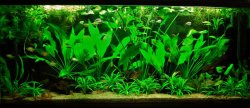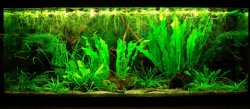Crazybob
Fish Fanatic
Hey all,
After 8 glorious years my oscar has died (he will be given a viking funeral) and I am going to be moving my fish from my 40 gallon tank to the 75 gallon. My current plan is to put down a layer (1/2 - 1") of dirt and another 1/2 - 2" of playsand on top of it. Currently in the 40 gal I am only using play sand with mixed results of plant survival. Currently I have a few amazon swords, anubias, and some java ferns.
If I proceed down this path am I going to need a heavily planted tank or will having a few plants still work? I don't particularly want to have to deal with providing fertilizer for the plants with the innert sand but I also don't want to be fighting algae by having the dirt down.
Any advice would be appreciated. Thanks for the help.
Tank Set up as follows:
75 gallon tank
Filtration: marineland C360 canister filter
Lighting: Current USA Satellite Freshwater LED Plus
After 8 glorious years my oscar has died (he will be given a viking funeral) and I am going to be moving my fish from my 40 gallon tank to the 75 gallon. My current plan is to put down a layer (1/2 - 1") of dirt and another 1/2 - 2" of playsand on top of it. Currently in the 40 gal I am only using play sand with mixed results of plant survival. Currently I have a few amazon swords, anubias, and some java ferns.
If I proceed down this path am I going to need a heavily planted tank or will having a few plants still work? I don't particularly want to have to deal with providing fertilizer for the plants with the innert sand but I also don't want to be fighting algae by having the dirt down.
Any advice would be appreciated. Thanks for the help.
Tank Set up as follows:
75 gallon tank
Filtration: marineland C360 canister filter
Lighting: Current USA Satellite Freshwater LED Plus





 /
/

